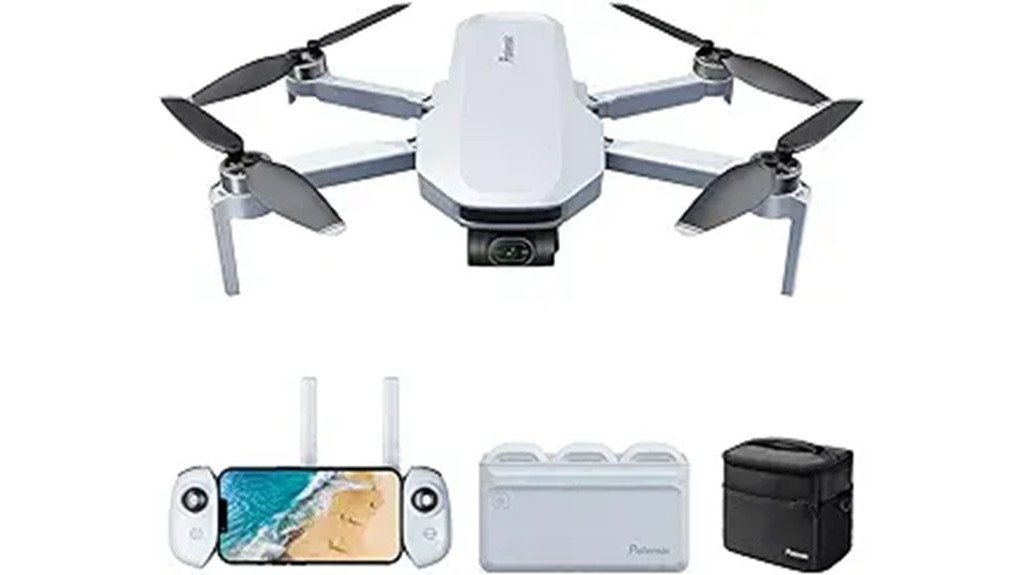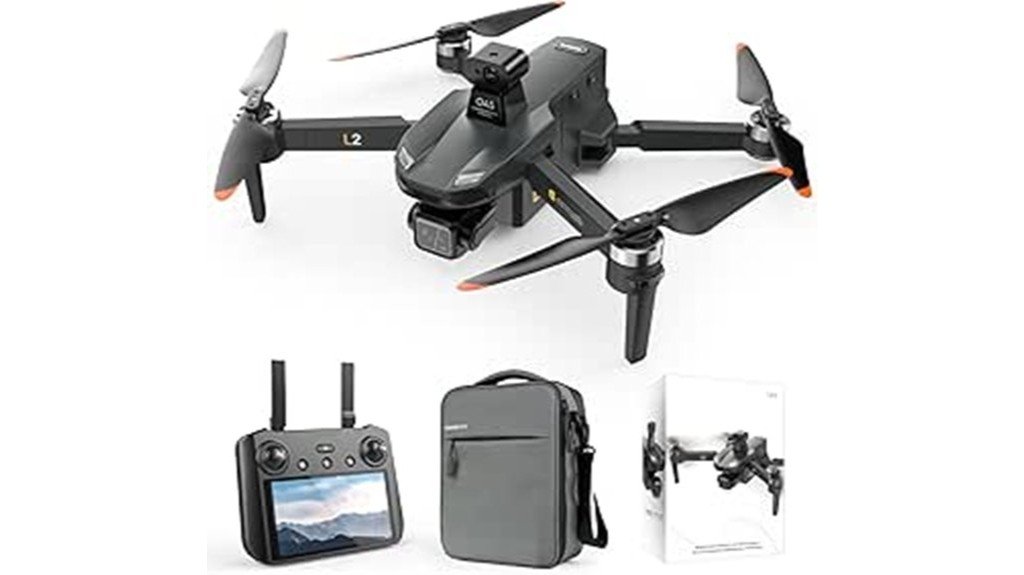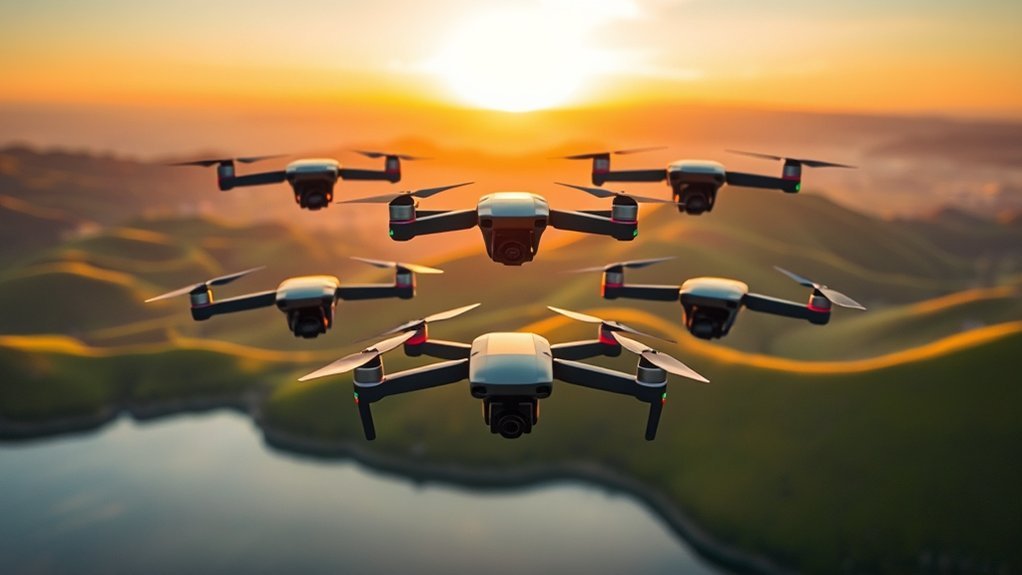In 2025, filmmakers are turning to the DJI Mini 4K for its exceptional 4K UHD capabilities. This drone, along with others on our list, can transform your aerial shots into mesmerizing visuals. But with so many options available, how do you choose the right one for your projects? Let’s explore the top five drones that can elevate your cinematography and help you capture stunning footage from above.
DJI Mini 4K Drone with 4K UHD Camera

The DJI Mini 4K Drone with its 4K UHD camera is perfect for aspiring filmmakers and hobbyists keen to capture stunning aerial footage without the hassle of FAA registration, thanks to its lightweight design under 249 grams. With a robust wind resistance of 38kph and an impressive altitude capability of 4,000 meters, you can shoot in various conditions. The 3-axis gimbal guarantees your footage remains stable and cinematic. Plus, you’ll appreciate the extended battery life options, offering up to 93 minutes of flight. With user-friendly features and intelligent flight modes, mastering aerial photography has never been easier.
Best For: Aspiring filmmakers and hobbyists who want to capture stunning aerial footage without the hassle of FAA registration.
Pros:
- High-quality 4K UHD camera with 3-axis gimbal for stable, cinematic footage.
- Lightweight design (under 249 g) eliminates the need for FAA registration.
- User-friendly features and intelligent flight modes make aerial photography accessible to beginners.
Cons:
- Limited to a maximum altitude of 4,000 meters, which may not satisfy advanced users.
- Battery life may still be shorter compared to more advanced drones.
- Some advanced features may require additional learning for optimal use.
DJI Mini 3 Drone with Camera

For aspiring filmmakers and content creators seeking high-quality aerial shots without the hassle of cumbersome equipment, the DJI Mini 3 Drone with Camera is a top choice. Weighing just 248 grams, it’s lightweight and requires no FAA registration for recreational use. With a flight time of up to 38 minutes, the drone captures stunning 4K UHD video thanks to its advanced 3-axis gimbal and Dual Native ISO. Wind resistance of level 5 guarantees stable footage, while smart features like True Vertical Shooting and QuickShots make it incredibly user-friendly. Plus, its compact, foldable design makes it easy to take anywhere.
Best For: Aspiring filmmakers and content creators looking for a lightweight, easy-to-use drone that delivers high-quality aerial footage.
Pros:
- Excellent 4K UHD video quality with advanced stabilization from the 3-axis gimbal.
- Lightweight design (248 grams) allows for easy transport and no FAA registration for recreational use.
- User-friendly features like True Vertical Shooting and QuickShots make it ideal for beginners.
Cons:
- Limited flight time of 38 minutes under normal conditions, which may require additional batteries for extended use.
- Wind resistance is only rated at level 5, which may affect stability in stronger winds.
- Requires activation via the DJI Fly App, which may be an inconvenience for some users.
TD31LCD RC Drone with LCD Screen
https://m.media-amazon.com/images/I/71lPGusPedL._AC_SX679_.jpg
Designed with both beginners and adults in mind, the TD31LCD RC Drone with LCD Screen stands out for its user-friendly features and impressive digital image transmission capabilities. You’ll appreciate the built-in LCD display that eliminates the need for app connections. With four powerful brushless motors, this drone guarantees quiet and stable flights. Its foldable design makes it easy to transport, and it includes a carrying case for your convenience. Enjoy features like headless mode, one-key take-off, and speed adjustments to enhance your flying experience. Rated 4.1 stars, it’s a solid choice for aerial photography enthusiasts.
Best For: Beginners and adults seeking a reliable and user-friendly drone for aerial photography.
Pros:
- Built-in LCD display allows for easy monitoring without the need for an app.
- Foldable design and lightweight construction make it highly portable for outdoor use.
- Powerful brushless motors provide stable and quiet flights, enhancing the overall flying experience.
Cons:
- Battery duration of approximately 15 minutes may be considered short by some users.
- Mixed reviews on camera quality and video performance may not meet all expectations.
- Limited storage capacity as it requires a separate SD card for photo and video storage.
Potensic ATOM 3-Axis Gimbal 4K GPS Drone

Weighing in at under 249 grams, the Potensic ATOM 3-Axis Gimbal 4K GPS Drone is perfect for filmmakers on the go who want high-quality aerial shots without the hassle of FAA registration. Its compact design fits in your palm, making it easy to carry. Equipped with a 12MP camera and SONY CMOS sensor, you can record stunning 4K video at 30fps. The 3-axis gimbal guarantees smooth footage, even in windy conditions. With 96 minutes of flight time across three batteries and a user-friendly remote, this drone elevates your cinematography experience effortlessly. Plus, it includes a 64GB micro SD card for added convenience.
Best For: Filmmakers and content creators seeking a portable, easy-to-use drone for capturing high-quality aerial footage without the need for FAA registration.
Pros:
- Compact and lightweight design makes it easy to carry and transport.
- High-quality 4K video recording at 30fps with a stable 3-axis gimbal for smooth footage.
- User-friendly features including visual tracking and multiple QuickShots for creative shooting options.
Cons:
- Limited to a maximum transmission range of 6 km, which may not satisfy advanced users.
- The drone’s small size may limit battery capacity and additional features compared to larger models.
- Firmware updates may require user attention for optimal performance and shooting quality.
Upgraded Pro Drone with Camera for Adults

If you’re an adult looking to elevate your cinematography game, the Upgraded Pro Drone with Camera offers features that cater specifically to your creative needs. With 4K UHD photo and video capture, you can produce stunning visuals. Enjoy long-distance capabilities with a range of up to 5 miles and a height of 2624 feet. Its 3-axis gimbal and EIS anti-shake technology guarantee smooth footage, while the 50x digital zoom and 130° FOV lens provide versatile shooting angles. Plus, with 84 minutes of flight time and advanced GPS features, you’ll capture breathtaking moments effortlessly. This drone is perfect for enhancing your aerial shots!
Best For: Adults looking to enhance their cinematography skills with a high-quality drone capable of capturing stunning aerial footage.
Pros:
- High-resolution 4K UHD photo and video capture for professional-quality visuals.
- Extended flight time with two batteries, providing a total of 84 minutes of flying.
- Advanced features like GPS auto-return and 360° obstacle avoidance enhance user safety and ease of operation.
Cons:
- Outdoor calibration is necessary before flight, which may be inconvenient for some users.
- User feedback suggests potential improvements for the accompanying app.
- Slightly heavier than some other drones, which may affect portability.
Factors to Consider When Choosing a Drone for Cinematography
When you’re choosing a drone for cinematography, several key factors can make a big difference in your results. You’ll want to take into account camera quality, stabilization, flight time, portability, and intelligent flight modes to guarantee you capture stunning footage. Each aspect plays a crucial role in how effectively you can create the visuals you envision.
Camera Quality Importance
Camera quality plays an essential role in elevating your cinematographic projects. High-resolution cameras, especially those capable of 4K UHD video, deliver clearer and more detailed imagery, vital for professional-grade footage. Look for drones equipped with a 3-axis gimbal, which stabilizes your shots, minimizing shake and ensuring smooth motion—key for effective storytelling. Additionally, consider cameras with advanced low-light performance, like dual native ISO, for capturing stunning visuals during varying lighting conditions. Intelligent shooting modes, such as QuickShots, make it easier to automate dynamic aerial maneuvers. Finally, choose a drone that records at high frame rates, enabling slow-motion effects that can add a creative flair to your cinematography. Prioritize camera quality to truly enhance your aerial storytelling.
Stabilization Mechanisms Explained
Stabilization mechanisms are essential for achieving the smooth, cinematic footage you desire, especially in dynamic environments. A 3-axis gimbal is a must-have, as it compensates for drone movements in pitch, yaw, and roll, ensuring your shots remain steady. In windy conditions, effective stabilization systems maintain video quality and minimize shaky footage, which is vital for professional work. Advanced stabilization technologies can also enhance low-light performance, allowing you to capture stunning images during sunsets or nighttime. Additionally, incorporating electronic image stabilization (EIS) can further reduce vibrations, adding another layer of stability to your footage. When selecting a drone for cinematography, always consider the specific stabilization features, as they greatly impact the quality of your final video output.
Flight Time Considerations
Achieving smooth cinematic footage is just one part of the equation; flight time plays a significant role in your overall filming strategy. Longer battery life means you can capture extended shots without frequent landings or battery swaps, which can disrupt your creative flow. Most drones offer flight times between 15 and 90 minutes, so consider how this aligns with your shoot plans. Efficient battery management systems can optimize power usage, enhancing flight time for those detailed shots. Keep in mind that weather conditions, especially wind, can reduce actual flight time. Finally, the complexity of your shots matters—dynamic movements typically drain the battery faster, potentially limiting your shooting duration. Balancing these factors is essential for successful cinematography.
Weight and Portability
When selecting a drone for cinematography, weight and portability are essential factors that can greatly influence your filming experience. Drones under 249 grams typically don’t require FAA registration, making them easier to transport and use in various locations. Opting for a compact, foldable design enhances portability, allowing you to store and carry your drone effortlessly, especially when you’re on the move. Lightweight drones usually provide better maneuverability and stability, vital for capturing high-quality footage. Additionally, a lighter drone can improve battery performance, enabling longer flight durations without the burden of heavy equipment. This means you can enjoy more extensive shooting opportunities during a single outing, making your cinematography sessions more productive and enjoyable.
Intelligent Flight Modes
Intelligent flight modes can transform your cinematography experience by making complex aerial maneuvers effortless. Features like QuickShots enable automated movements such as Helix, Dronie, and Rocket, allowing you to capture stunning shots with minimal effort. Many drones also offer specialized modes, like True Vertical Shooting for social media or Panorama for breathtaking wide-angle views, enhancing your creative flexibility. With pre-programmed flight paths, you can achieve consistent, professional-looking footage without needing advanced piloting skills. Plus, Visual Tracking capabilities let the camera follow subjects autonomously, perfect for dynamic scenes. By integrating these intelligent flight modes, you’ll greatly reduce the learning curve, letting you focus on your creative vision rather than getting bogged down in complex controls.
Battery Life Management
Battery life management is a critical factor to evaluate when choosing a drone for cinematography, as it directly influences how long you can capture stunning aerial shots. Drones offering up to 114 minutes of total flight time with multiple battery swaps can greatly reduce your anxiety during shoots, allowing you to focus on creativity without frequent recharging breaks. Look for intelligent battery management systems that protect battery life and offer safe return-to-home (RTH) functionality in case of low battery. Quick charging capabilities can boost your workflow efficiency, letting you spend more time filming and less time waiting. Understanding that average flight times are typically around 30 to 38 minutes will also help you effectively plan your shooting schedules and shot lists.
User-Friendliness and Features
Choosing the right drone for cinematography means considering user-friendliness and essential features that enhance your filming experience. Look for user-friendly options like one-tap takeoff and landing; these let you focus on capturing stunning footage instead of mastering flight mechanics. A stable 3-axis gimbal is vital for achieving smooth, cinematic-quality shots, especially in dynamic conditions. Intelligent flight modes, such as QuickShots, automate complex movements, helping you create professional videos effortlessly. Extended battery life, with flight times up to 31 minutes, eases concerns about power during key moments. Finally, in-app learning resources can fast-track your skills, ensuring you fully utilize your drone’s capabilities and elevate your cinematography.

